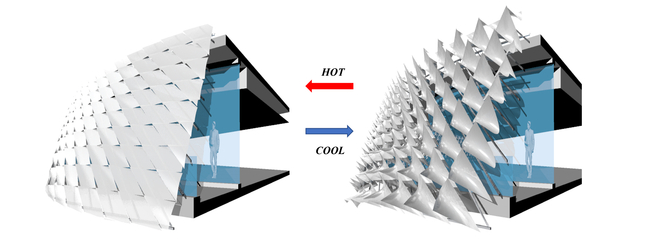- About Ajou
- Admission
- Academics
- Research
-
International
International
- Campus Life
-
News and Event
News and Event
-
AUT
AUT
Ajou News
NEW Architecture Prof. Lee Hwang’s Research Team Develops Automatic Temperature-Sensitive Building Façade Module
- 2021-11-16
- 2769

A research team led by Lee Hwang, Professor of Architecture at Ajou University, developed a building façade module that automatically responds to changes in temperature similarly to the way a cactus does—by opening and shutting “stomata” to adjust its own temperature.
Prof. Lee’s research team used smart materials and 4D printing to develop a temperature-sensitive building façade (visor) module. Related research findings were announced in the international Journal of Building Engineering on August 8, 2021. 4D printing is a technology that adds a time dimension to 3D printing, which prints three-dimensional shapes, thereby printing materials that change according to time.
The research team used shape memory materials that change shape according to temperature to imitate how cacti open and close their stomata. Cacti breathe through their stomata and use them to control light and humidity, thereby helping them survive in the desert. The research team combined shape memory nickel titanium alloy with shape memory high polymer, which allows the shape memory alloy to contract as the temperature rises and close its visor to shut the sunlight out. As the temperature drops, the shape memory high polymer curves outwards to open the visor.
With a miniaturized architectural structure, the research team verified that shape memory composite materials can be used to automatically open and shut an exterior wall according to temperature. Previous studies attempted to use “smart” materials that changed shape with the temperature, but their restoring force, which is the ability to return to their original shape, was poor and study proved to be limited accordingly. Prof. Lee’s research team combined nickel titanium alloy wire, which has little elasticity but significant restoring force, with shape memory high polymer, which has little restoring force but is very elastic. This combination enhanced the strain rate to 20%, and created a compound that repetitiously changes and restores without outside force.
Heating and cooling buildings accounts for a large share of the energy used in non-industrial sectors. The technology developed by Ajou University’s research team is expected to contribute to lowering indoor cooling loads.
“4D printing allows creation of a building that moves on its own using a variety of modules in a relatively easy and cost-effective way,” said Prof. Lee. “It can lower a building’s indoor cooling load and also be used in road shielding walls and solar panels.”
This research was sponsored by the Research Leadership Program of the Korean Ministry of Science and ICT (MSIT) and the National Research Foundation of Korea (NRF).

<Model of the research team’s building façade experiment – the façade opens and closes in accordance with the surrounding temperature.>
